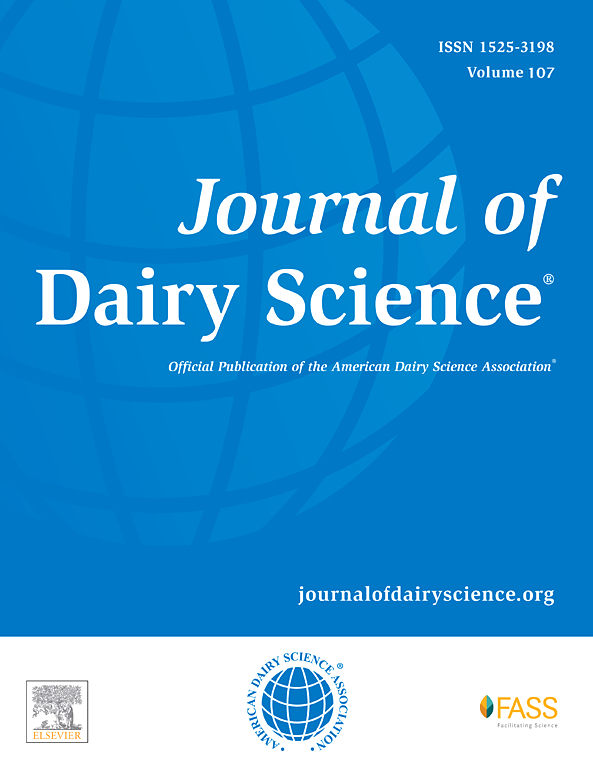挪威红奶牛的饲料效率和剩余采食量。
IF 3.7
1区 农林科学
Q1 AGRICULTURE, DAIRY & ANIMAL SCIENCE
引用次数: 0
摘要
牲畜生产中的饲料是一个主要的成本驱动因素,与该部门的温室气体排放密切相关。因此,提高牲畜的饲料效率,促进畜牧业生产的经济和环境可持续性具有很大的意义。剩余采食量(RFI)是奶牛饲料效率的常用指标之一。然而,RFI既有概念上的限制(例如,混淆测量误差和未观察到的异质性的影响),也有实际的限制(例如,负值和饲料效率的非单调性)。因此,本研究基于采集的54 d采食量和生产性能数据,采用随机饲料需求前沿法(SFRF)估算了48头泌乳早期至中期挪威红奶牛的饲料效率。考虑胎次、哺乳阶段、身体储备动员、未观察到的奶牛特异性异质性和统计噪声,SFRF预测了每头奶牛支持其生产和维持需求所需的最低采食量。然后通过两种方式估计每头奶牛的饲料效率:第一种是计算饲料效率得分,即每头奶牛的SFRF预测值与实际采食量的比值;第二种是计算每头奶牛的剩余采食量(SFI),即实际采食量与预测采食量之间的差值。进一步证明了进料效率可以分解为时不变和时变两个部分。结果表明,平均饲料效率评分为89.7%,且在研究期间不随时间变化。该评分表明10.3%的采食量为SFI。按绝对值计算,SFI平均为13.3 kg DM/周。然而,饲料效率最低的四分位奶牛的SFI几乎是饲料效率最高的四分位奶牛的5倍。此外,奶牛的采食量变化仅占总采食量变化的53.9%。其余46.1%的采食量变化是由统计噪声引起的。在奶牛特异性采食量变化中,82.1%是由于饲料效率的差异,而其余17.9%是由于其他未观察到的奶牛特异性异质性来源。当使用生命周期数据实施时,本研究中提出的饲料效率分解方法可以了解泌乳期内和泌乳期间饲料效率的时间轨迹。此外,它允许在整个生命周期内重复识别饲料效率。促进将饲料效率纳入育种计划。本文章由计算机程序翻译,如有差异,请以英文原文为准。
Feed efficiency and surplus feed intake among Norwegian Red dairy cows
Feed in livestock production is a major cost driver and closely linked to GHG emissions from the sector. Hence, there is a great deal of interest to improve feed efficiency of livestock and promote economic and environmental sustainability of livestock production. We estimated feed efficiency of 48 early- to mid-lactation Norwegian Red dairy cows based on intake and performance data collected for 54 d using a stochastic feed requirement frontier (SFRF). The SFRF predicted the minimum feed intake each cow required to support its production and maintenance needs, accounting for parity, lactation stage, body reserve mobilization, unobserved cow-specific heterogeneity, and statistical noise. Feed efficiency of each cow was then estimated in 2 ways: first by computing a feed efficiency score as a ratio of the prediction from the SFRF to the observed feed intake of each cow, and second by computing surplus feed intake (SFI) of each cow as a difference between observed and predicted feed intake. Furthermore, it was shown that feed efficiency can be decomposed into time-invariant and time-variant parts. Results showed that the average feed efficiency score was 89.7%, and it was time-invariant for the period covered during the study. The score implies 10.3% of the observed feed intake was SFI. In absolute terms, the SFI amounted to 13.3 kg of DM/wk on average. However, cows in the least feed efficient quartile had SFI of almost 5 times higher than cows in the most feed efficient quartile. Furthermore, cow-specific feed intake variation accounted for only 53.9% of the total feed intake variation. The remaining 46.1% of the feed intake variation was due to statistical noise. Out of the cow-specific feed intake variation, 82.1% was due to differences in feed efficiency, whereas the remaining 17.9% was due to other sources of unobserved cow-specific heterogeneity. When implemented with lifetime data, the feed efficiency decomposition approach presented in this study enables understanding of the temporal trajectory of feed efficiency within and across lactations. Furthermore, it allows identification of feed efficiency that is repeatable over lifetime, facilitating the inclusion of feed efficiency in breeding programs.
求助全文
通过发布文献求助,成功后即可免费获取论文全文。
去求助
来源期刊

Journal of Dairy Science
农林科学-奶制品与动物科学
CiteScore
7.90
自引率
17.10%
发文量
784
审稿时长
4.2 months
期刊介绍:
The official journal of the American Dairy Science Association®, Journal of Dairy Science® (JDS) is the leading peer-reviewed general dairy research journal in the world. JDS readers represent education, industry, and government agencies in more than 70 countries with interests in biochemistry, breeding, economics, engineering, environment, food science, genetics, microbiology, nutrition, pathology, physiology, processing, public health, quality assurance, and sanitation.
 求助内容:
求助内容: 应助结果提醒方式:
应助结果提醒方式:


